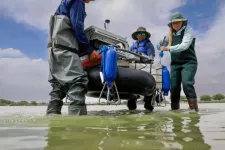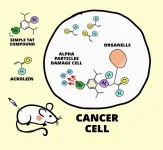(Press-News.org) Recurrent bouts of systemic lupus erythematosus, marked by the body’s immune system attack of its own tissues, closely tracked with measureable upticks in growth in the gut of a certain species of bacteria.
New research from NYU Grossman School of Medicine shows that bacterial blooms of the gut bacterium Ruminococcus blautia gnavus occurred at the same time as disease flare-ups in five of 16 women with lupus of diverse racial backgrounds studied over a four-year period. Systemic lupus erythematosus involves damaging inflammation, especially in the kidneys, but also in joints, skin, and blood vessels. Four of these study patients with R. gnavus blooms had severe cases of the most common and kidney-specific form of the disease, lupus nephritis, while one had a severe example of lupus involving inflammation in multiple joints.
Publishing in the Annals of Rheumatic Diseases online June 27, the team’s analysis of these lupus patients’ gut bacterial blooms identified 34 genes that already had established links to the bacterium’s growth in people with inflammation. While the specific causes of lupus, which affects as many as 1.5 million Americans, remain unknown, many experts suspect that bacterial imbalances trigger inherited genetic factors responsible for the disease.
This study also investigated how tightly these patients’ immune system antibodies bonded to structures in the bacterial wall, much like they would an invading virus. These antibodies showed a strong affinity to specific bacterial lipoglycan molecules that are known triggers of inflammation. These lipoglycans were found to be common in R. gnavus strains in lupus patients but not in healthy people. Antibodies are a major cause of the body damage in this disease, and this diagnostic antibody response, the researchers say, highlights the important role played by R. gnavus in the autoimmune disease.
“Our findings provide the strongest evidence to date that silent growths of Ruminococcus blautia gnavus are tied to active serious renal disease in lupus patients,” said study lead investigator Doua Azzouz, PhD.
“Interestingly, our study also established this common bacterial link among a racially diverse group of females with varying forms of lupus,” said Azzouz, a postdoctoral researcher in the Department of Medicine at NYU Langone Health. Lupus is more common in women than in men, and the disease affects more Blacks, Hispanics, and Asians than Whites.
“Our goal is to use our growing understanding of the biological pathways that underpin the disease to develop new treatments that prevent or treat flares for all forms of lupus,” said study senior investigator and immunologist Gregg Silverman, MD.
“Such future treatments for lupus, especially lupus nephritis, could potentially decrease the use of drugs designed to dampen the immune system and instead promote the use of less-toxic antibacterial agents, probiotics or dietary regimens that prevent imbalances such as Ruminococcal blooms in the local gut bacterial population, or microbiome,” said Silverman, the Mamdouha S. Bobst Professor of Internal Medicine in the Departments of Medicine and Pathology at NYU Langone Health.
Previous research by Silverman’s team showed that R. gnavus blooms weaken the gut wall barrier, prompting bacterial leakages that in turn trigger inflammatory and overactive immune responses.
Silverman, who also serves as associate director of rheumatology at NYU Langone, says the team plans to extend the current research to more patients at other medical centers. The team also has plans for further experiments in mouse models of lupus to see how R. gnavus colonization triggers lupus and whether in mice bred to develop lupus-like symptoms R. gnavus blooms speed up or otherwise affect the severity of flares and inflammation.
The researchers say they also want to conduct experiments on various lipoglycan molecules from different R. gnavus strains to see if any particular part of the molecular structure is key to triggering inflammation or if other lipoglycans also prompt an immune response tied to lupus or other diseases of the gut, including Crohn’s.
For the study, researchers used stool and blood samples from lupus patients being treated at NYU Langone. All study participants were being closely monitored for disease flare-ups. Test results were compared with those of 22 female volunteers of similar age and racial background who did not have lupus and were otherwise healthy.
As an autoimmune disease, systemic lupus erythematosus can lead to widespread inflammation and long-term tissue damage in affected organs. According to researchers, about half of patients develop lupus nephritis, of whom one-quarter are likely to experience end-stage renal disease that may require regular blood dialysis and even kidney transplantation.
Funding support for the study was provided by National Institute of Health grants UL1TR000038, P30CA016087, R01AR42455, P50AR070591, and HHSN272201400019C. Additional funding support was provided by the Lupus Research Alliance, the Judith and Stewart Colton Autoimmunity Center at NYU Langone, and the P. Robert Majumder Charitable Trust.
Besides Silverman, other NYU Langone researchers involved in this study are Ze Chen, Peter Izmirly, Lea Ann Chen, Zhi Li, Chongda Zhang, Adriana Heguy, Davis Mieles, Kate Trujillo, Alejandro Pironti, Gregory Putzel, David Fenyo, and Jill Buyon. Other study co-investigators are Dominik Schwudke and Nicolas Gisch, at the Leibniz Lung Center in Borstel, Germany; and Alexander Alekseyenko at the Medical University of South Carolina in Charleston.
Media Inquiries:
David March
212-404-3528
david.march@nyulangone.org
END
Lupus flare-ups strongly linked to specific bacterial growth in gut
2023-06-27
ELSE PRESS RELEASES FROM THIS DATE:
This self-driving boat maps underwater terrain
2023-06-27
EL PASO, Texas (June 27, 2023) – Step aside self-driving cars, self-driving boats are here — and they can do more than take you on a cruise.
Researchers at The University of Texas at El Paso have constructed a fully autonomous boat that can carry out bathymetric surveys — surveys of the depth and terrain of bodies of water like oceans, rivers and lakes. The team hopes the robotic boat can help simplify the survey process, which usually takes a crew of individuals to complete, as well as assist ...
A new generic treatment for multiple types of cancer
2023-06-27
Researchers led by Katsunori Tanaka at the RIKEN Cluster for Pioneering Research (CPR) in Japan and Hiromitsu Haba at the RIKEN Nishina Center for Accelerator-Based Science (RNC) have developed a new technique that has the potential to generically treat several kinds of cancer, with fewer negative side effects than currently available methods. Published on June 27 in Chemical Science, the proof-of-concept study showed that tumors in mice grew almost three times less and survival was 100% after just one injection of a compound that is designed to emit small amounts of alpha radiation from the inside of cancer cells, thus killing them but sparing ...
Why Saudi Arabia's "The Line" isn’t a revolution in urban living
2023-06-27
In October, the excavation work for the superlative construction project began. What some consider an ideal ecological city, others call a promotional gimmick. Researchers from the Complexity Science Hub now show why The Line should not be a showcase for future cities.
"It's the embodiment of the dream to start from scratch and completely rethink a city," says Rafael Prieto-Curiel, who researches cities at the Complexity Science Hub. The Line is planned to be a city built from nothing in the desert. It is to consist of two gigantic, unbroken rows of skyscrapers, with living space in between. 170 kilometers long. 200 meters wide. 500 meters high, higher ...
Magnetic bacteria point the way
2023-06-27
Magnetotactic bacteria, which can align with the Earth’s magnetic field, have been discovered in a new location. Previously observed on land and in shallow water, analysis of a hydrothermal vent has proven that they can also survive deep under the ocean. The bacteria were able to exist in an environment that was not ideal for their typical needs. Magnetotactic bacteria are of interest not only for the role they play in Earth’s ecosystem, but also in the search for extraterrestrial life. Evidence of their existence can remain in rocks for billions of years. Their magnetic inclinations can also provide ...
Over 100 leaders in aging and longevity to present their latest research at the 10th ARDD
2023-06-27
June 27, 2023, the University of Copenhagen is excited to reveal the speakers, program and travel grants for the 10th Aging Research & Drug Discovery Meeting, the World's Largest Conference on Aging Research in the biopharmaceutical industry that will transpire on August 28 - September 1, 2023 on-site at the Ceremonial Hall, University of Copenhagen, and online.
According to the United Nations, the proportion of people aged over 65 now outnumber children younger than 5. The enormous growth in the elderly population is posing a socioeconomic challenge to societies worldwide, and necessitates new sweeping interventions for age-associated ...
A new method to keep thickening agents tiny in transport and big in application
2023-06-27
Osaka, Japan – Many commercial products such as food, cosmetics, and inks contain cellulose nanofiber (CNF) as a thickening agent. However, CNFs have some limitations that prevent their more widespread use. Now, researchers from Osaka University have demonstrated a method of dehydrating CNFs to a dense powder without affecting their three key properties. Their findings are published in Macromolecular Rapid Communications.
Video for your easy understanding
https://youtu.be/PAEd36v_SjI
CNFs are a popular thickening agent because small amounts in water have high transparency, high viscosity, and the viscosity ...
Two technology-based approaches that improved hand hygiene compliance are featured at infection prevention conference
2023-06-27
Orlando, Fla., June 27, 2023 – Hand hygiene is the simplest, most effective way to prevent the spread of infections in healthcare, yet healthcare worker adherence is often low. Infection preventionists at two health systems will present their successful hand hygiene interventions at the Association for Professionals in Infection Control and Epidemiology’s (APIC’s) Annual Conference in Orlando Florida, June 26-28.
University of Michigan Health sustains 95% hospital-wide hand hygiene compliance through creation ...
Updated guidance shows how hospitals should protect patients from resistant infections
2023-06-27
ARLINGTON, Va. (June 27, 2023) — A group of five medical organizations have released updated recommendations for the prevention of methicillin-resistant Staphylococcus aureus, known as MRSA, transmission and infection. MRSA causes approximately 10% of hospital-associated infections in the United States and such infections are associated with an increased risk of death. Certain infections caused by MRSA rose by as much as 41% during the pandemic after falling in preceding years.
Strategies to Prevent Methicillin-Resistant Staphylococcus aureus Transmission and Infection in Acute Care Hospitals provides evidence-based, ...
How secure are voice authentication systems really?
2023-06-27
Computer scientists at the University of Waterloo have discovered a method of attack that can successfully bypass voice authentication security systems with up to a 99% success rate after only six tries.
Voice authentication – which allows companies to verify the identity of their clients via a supposedly unique “voiceprint” – has increasingly been used in remote banking, call centers and other security-critical scenarios.
“When enrolling in voice authentication, ...
Synthesis of peripherally annulated phenanthroporphyrins
2023-06-27
Prof. Okujima, in collaboration with Prof. Kobayashi at Shinshu University, reported the synthesis, molecular structure, optical properties and electronic structure of unusual phenanthrene-fused porphyrins.
Precursor porphyrins fused with aryl-substituted bicyclo[2.2.2]octadiene afforded the corresponding arylbenzoporphyrins (arylBPs) by retro Diels–Alder reaction. Unusual phenanthroporphyrins were obtained via the intramolecular Scholl reaction of arylBPs. We analyzed the optical and electronic structures using magnetic circular dichroism spectroscopy and time-dependent density functional theory calculations.
Our ...






